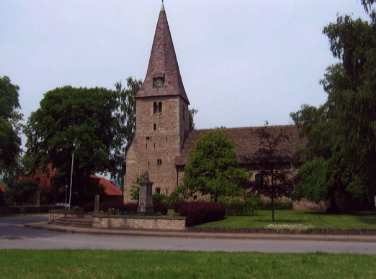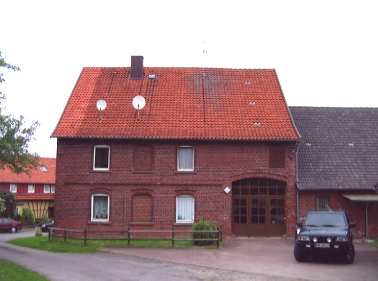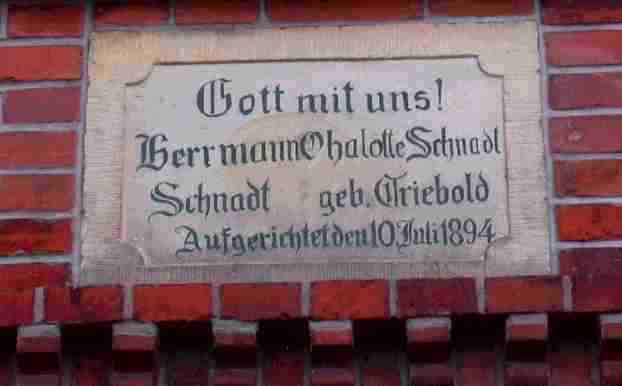
Evangelical Lutheran church "Johannes der Täufer" (John the Baptist) in Fuhlen (Hessisch- Oldendorf)

House No. 61 in Hesslingen

God with us! Hermann Schnadt - Cha(r)lotte Triebold; Built on July 10, 1894
Emigration from Hesslingen to Illinois and Iowa
Most Schnadts who today live in the United States of America can be traced from the little village Hesslingen near Hessisch-Oldendorf on the river Weser. The Schnadts already lived there in the house No. 61 for about 230 years. Their church was in the neighboring town Fuhlen. Johann Simon Schnadt, the first Schnadt from Hesslingen, was born in neighboring Goldbeck. His parents lived in Wahrendahl in their last years of life. From there Johann Simon Schnadt went to Hesslingen where he married Christina Louisa Schuette in 1777. The couple had had ten children of whom the youngest, Christian Gottlieb, remained in the house No. 61. He married Wilhelmine Caroline Waechter in 1818. The couple had four children. Christian Gottlieb Schnadt died early in December 1825 when the youngest child, Georg Heinrich Ferdinand Schnadt, was just a year old. His wife was left alone with the care for the four little children.
|
Evangelical Lutheran church "Johannes der Täufer" (John the Baptist) in Fuhlen (Hessisch- Oldendorf) |
House No. 61 in Hesslingen |
| In 1827 Wilhelmine Caroline married Johann Friedrich Gottlieb Schnaat from Wahrendahl, a cousin of
her first husband. Four children resulted from this marriage, of which
Ludwig Ferdinand Schnadt (b. 1833) continued the line of owners of the
house No. 61. In 1894 the house was rebuilt from a half-timbering making into a
clinker building in the following generation by Hermann
Schnadt,
which is shown on a plate over the entrance. The possession line of the
"Schnadt-owners" has broken in recent time.
|
God with us! Hermann Schnadt - Cha(r)lotte Triebold; Built on July 10, 1894 |
| Heinrich Christian Ferdinand Schnadt ( * 1844 ), a nephew of Georg Heinrich Ferdinand Schnadt, got the permission to leave his native country in 1860. He travelled with a group of emigrants from Schaumburg to Illinois (USA). According to the 1890 census he settled in Northfield, Cook County , in 1861. There he married Charlotte Meyer. She was the daughter of Ludwig Meyer and his wife Rosina nee Böger. Ludwig Meyer came from Holtensen (Schaumburg), Rosina Böger from Rannenberg. The Meier (Meyer) family came to the USA with other Schaumburg families in 1847. The church register of 1866 noted in No. 14 of the marriage register in German language: "On the 23 rd of December were married through the parishioner E. Keuchen: Heinrich Schnadt of Grafschaft Schaumburg and Charlotte Meyer of here ". "Here" meant St. Peter UCC Church in Northfield (Vol. II, pg. 134 No.14). Descendants of this family still live in Illinois. Much more family data can be found in the church records of St. Peter's Evangelical Neighborhood Church, Northfield, Il., which were written in German up to the beginning of the 20th century. |
St. Peter's United Church of Christ (1875) in Northfield / Illinois |
|
Heinrich Schnadt and his wife Engel Marie nee Biesterfeld |
When Georg Heinrich Ferdinand Schnadt was about 25 years old, he left Hesslingen for emigration to the United Staates. Presumable he had no permission of the authorities to leave the country. Obviously he had moved with a trek of Schaumburg immigrants to the west of Chicago to build a new life there. Some years after emigration to America he married Engel Marie Biesterfeld, who also had emigrated with her parents from Schaumburg (Algesdorf No. 11). The Schnadt- farm must have been in the area of Ontarioville (IL). The couple Heinrich Schnadt and Engel Marie Biesterfeld ( see picture ) are the parents of many Schnadts, who live in the United States of America today. |
|
They joined the Protestant Lutheran Church St. John. This church was founded in 1851 by Schaumburg immigrants two miles west of Roselle (Cook Co.). This place was also called "Rodenberg" in memory of some Rodenberg emigrants to their German native village Rodenberg at the Deister. Already two years later, in 1853, the parish had to build a new church building because of the increase of church members. All eight children of the couple were baptized in this church. Henry (1904) and Engel Marie Schnadt (1902) were buried on the cemetery of St. John's. Today, the gravestone still can be found.
|
Grave of Henry and Mary Schnadt courtesy of Rev. Mark Brockhoff (St. John's Lutheran Church, Roselle) |
The above mentioned Heinrich Christoph Schnadt, Henry's and Mary's oldest son, moved to Sumner in Iowa and therefore is the progenitor of the Iowa family branch. His youngest brother, Hermann, stayed in Illinois and founded in 1910 with others the Bartlett State Bank.
| More than a million and a half dollars made up the assets of the Bartlett State Bank, which was celebrating on September 29, 1950 the 40th anniversary of its founding. Active in its operation were (left to right) Hermann W. Schnadt (president), Irma Hanson (bookkeeper), Stella Schnadt (teller) and Herbert E. Schnadt (cashier). Interesting facts surrounding the history of the bank include the following: The auditor of public accounts for the State of Illinois issued a permit to organize the bank on June 6, 1910. The stock in the bank was subscribed for on Sept. 23, 1910. The stockholders organized on Sept. 24, 1910 a meeting held in Herman Schnadt's hall in Bartlett and elected E.J. Schmidt president and Herman Schnadt vice-president. |
(left to right) Hermann W. Schnadt (president), Irma Hanson (bookkeeper), Stella Schnadt (teller) and Herbert E. Schnadt (cashier) |
The bank has had its exiting moments, being robbed in December of 1929. In 1935 the cashier was waylaid and held up when returning to Bartlett with money secured from an Elgin bank. Hermann W. Schnadt, who had served as the vice-president from its inception was elected president in January 1950. He was 81 years old at this time. His son Herbert was working in the bank since 1929.
The poet
|
|
Frederick L. Schnadt, a brother of Herman W. Schnadt,
died in Roger's park Illinois 1949 at the age of 91 years. Frederick
lived there since 1939. He was known to thousands of Roger Park
residents as a person of wisdom and courage. He was poet, journalist,
farmer, worker, businessman and a philosopher. His main interest was the
peace. For this ideal he wrote many letters and poems to local, state
and national government leaders, to woman's groups and to all types of
organizations. |
|